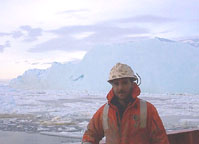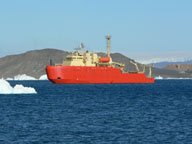August 03, 2005
Study: Human activity causing global warming
CARBONDALE, Ill. -- New evidence proves human activity, not Mother Nature, is to blame for worrisome warming trends the world over, according to Nature magazine's Aug. 4 cover story.The scientific journal article — under the cover page headline: "A Long Shelf Life: Larsen-B Collapse Follows 10,000 Years of Stability"— indicates today's global warming is unnatural, is escalating at an unparalleled rate and surpasses every such documented trend since the last great ice age some 10,000 years ago.
Paleobiologist Scott E. Ishman is the article's co-author. One of about a dozen highly respected U.S. experts on Antarctica, he is an associate professor of geology at Southern Illinois University Carbondale.
In mid-February, he and two of the University's undergraduate students joined 15 peers — including Antarctic expedition leader Eugene Domack, a geologist at New York's Hamilton College — aboard the R.V. L.M. Gould. The research vessel plied northwest Antarctica's Weddell Sea for a month during polar summer.
Among the team's recent findings: Human behavior is the primary cause of rapidly increasing air and ocean temperatures around the globe.
How can the researchers be so sure?
By studying fossilized shells of foraminifera (for-ah-min-IF-er-ah), single-cell marine creatures that live on the ocean floor and are preserved in the sediment cores, the team can tell what the region's environment was like in the past and can better interpret what's happening with climate today.
On this trip, scientists pulled cores of Antarctic seafloor sediment from an area formerly capped by the Antarctic Peninsula's Larsen B ice shelf, a sprawling nearly 600-foot thick sheet of ice larger than Rhode Island. It broke apart in 2002 before almost entirely melting a year after.
The National Science Foundation's Office of Polar Programs provided funding for this and earlier studies in the region.
Here's how Ishman summarizes this week's findings: "The global warming we're experiencing today is a matter of great concern because it's not part of any natural cycle we've observed in the last 10,000 years.
"The big increases that have been observed in greenhouse gas production —which results from burning fossil fuels and factory and auto emissions associated with that — is certainly one of the most likely culprits," he adds.
"Recent warming in the Antarctic has really accelerated in the last 50 years," Ishman notes. "In that time, we've seen average increase of 6.5 degrees Fahrenheit in the Antarctic ice shelf area, which is startling."
If they continue, the upward ticks in temperatures may threaten folks far and wide.
"Sea levels are already rising and could continue to rise at much more rapid rates. So that means increased chances of coastal area flooding, loss of life and property," Ishman said. "It's also going to create shifts in the climate zones. Instead being the breadbasket, we could be the desert and Canada could become the breadbasket.
"There could also be changes in climate patterns, increases in hurricane frequency and further increases in storm intensities."
Ishman hopes presenting and interpreting the data will encourage people to change.
"We need to try to reduce our emissions and we can do that by cutting down on our demand for fossil fuels through alternative energy sources, conservation and developing cleaner fuels. Or at least developing technologies to clean up emissions," he says.
Leading in research, scholarly and creative activities is among the goals of Southern at 150: Building Excellence Through Commitment, the blueprint the University is following as it approaches its 150th anniversary in 2019.
Photo 1: ice shelf
Ice shelf — The Larsen B ice shelf off northwest Antarctica before it began melting in 2002. Recent warming has significantly impacted the natural conditions in the region. Antarctic experts say the disappearances, breakups and retreats of the ice shelves are the largest single event of their kind in 10,000 years.
An Aug. 4 Nature magazine story, co-authored by Southern Illinois University Carbondale marine geologist Scott Ishman, shows human activity is to blame for the warming trends
Photo provided.
Photo 2: Ishman.jpg
Antarctic expert — Marine geologist Scott Ishman in his favorite research area, the Antarctic Penisula. An associate professor of geology at Southern Illinois University Carbondale, Ishman and his peers authored an Aug. 4 cover story on global warming for Nature magazine. The National Science Foundation funded the expedition.
Photo provided
Photo 3: research vessel
Floating laboratory — Eighteen scientists aboard the research vessel RMV L. M. Gould conducted numerous climate and ocean studies off the Antarctic Peninsula in mid-February, its polar summer. Scott Ishman, an associate professor of geology at Southern Illinois University Carbondale, joined the expedition. The team’s findings on global warming are featured in the Aug. 4 issue of Nature magazine.
Photo provided



